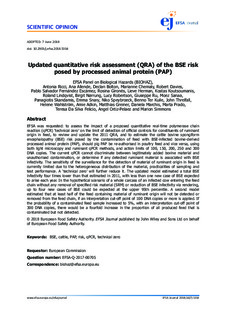Updated quantitative risk assessment (QRA) of the BSE risk posed by processed animal protein (PAP)
| dc.contributor.author | Ricci, Antonia | |
| dc.contributor.author | Allende, Ana | |
| dc.contributor.author | Bolton, Declan | |
| dc.contributor.author | Chemaly, Marianne | |
| dc.contributor.author | Davies, Robert | |
| dc.contributor.author | Fernandez Escamez, Pablo Salvador | |
| dc.contributor.author | Girones, Rosina | |
| dc.contributor.author | Herman, Lieve | |
| dc.contributor.author | Koutsoumanis, Kostas | |
| dc.contributor.author | Lindqvist, Roland | |
| dc.contributor.author | Nørrung, Birgit | |
| dc.contributor.author | Robertson, Lucy | |
| dc.contributor.author | Ru, Giuseppe | |
| dc.contributor.author | Sanaa, Moez | |
| dc.contributor.author | Skandamis, Panagiotis | |
| dc.contributor.author | Snary, Emma | |
| dc.contributor.author | Speybroeck, Niko | |
| dc.contributor.author | Ter Kuile, Benno | |
| dc.contributor.author | Threlfall, E.J. | |
| dc.contributor.author | Wahlström, Helene | |
| dc.contributor.author | Adkin, Amie | |
| dc.contributor.author | Greiner, Matthias | |
| dc.contributor.author | Marchis, Daniela | |
| dc.contributor.author | Prado, Marta | |
| dc.contributor.author | Da Silva Felicio, Teresa | |
| dc.contributor.author | Ortiz‐Pelaez, Angel | |
| dc.contributor.author | Simmons, Marion M | |
| dc.date.accessioned | 2019-01-11T07:57:20Z | |
| dc.date.available | 2019-01-11T07:57:20Z | |
| dc.date.created | 2018-12-26T13:00:39Z | |
| dc.date.issued | 2018 | |
| dc.identifier.issn | 1831-4732 | |
| dc.identifier.uri | http://hdl.handle.net/11250/2580268 | |
| dc.description.abstract | EFSA was requested: to assess the impact of a proposed quantitative real-time polymerase chainreaction (qPCR)‘technical zero’on the limit of detection of official controls for constituents of ruminantorigin in feed, to review and update the 2011 QRA, and to estimate the cattle bovine spongiformencephalopathy (BSE) risk posed by the contamination of feed with BSE-infected bovine-derivedprocessed animal protein (PAP), should pig PAP be re-authorised in poultry feed and vice versa, usingboth light microscopy and ruminant qPCR methods, and action limits of 100, 150, 200, 250 and 300DNA copies. The current qPCR cannot discriminate between legitimately added bovine material andunauthorised contamination, or determine if any detected ruminant material is associated with BSEinfectivity. The sensitivity of the surveillance for the detection of material of ruminant origin in feed iscurrently limited due to the heterogeneous distribution of the material, practicalities of sampling andtest performance. A‘technical zero’will further reduce it. The updated model estimated a total BSEinfectivity four times lower than that estimated in 2011, with less than one new case of BSE expectedto arise each year. In the hypothetical scenario of a whole carcass of an infected cow entering the feedchain without any removal of specified risk material (SRM) or reduction of BSE infectivity via rendering,up to four new cases of BSE could be expected at the upper 95th percentile. A second modelestimated that at least half of the feed containing material of ruminant origin will not be detected orremoved from the feed chain, if an interpretation cut-off point of 100 DNA copies or more is applied. Ifthe probability of a contaminated feed sample increased to 5%, with an interpretation cut-off point of300 DNA copies, there would be a fourfold increase in the proportion of all produced feed that is contaminated but not detected. | nb_NO |
| dc.language.iso | eng | nb_NO |
| dc.rights | Attribution-NonCommercial-NoDerivatives 4.0 Internasjonal | * |
| dc.rights.uri | http://creativecommons.org/licenses/by-nc-nd/4.0/deed.no | * |
| dc.title | Updated quantitative risk assessment (QRA) of the BSE risk posed by processed animal protein (PAP) | nb_NO |
| dc.type | Journal article | nb_NO |
| dc.type | Peer reviewed | nb_NO |
| dc.description.version | publishedVersion | nb_NO |
| dc.source.volume | 16 | nb_NO |
| dc.source.journal | EFSA Journal | nb_NO |
| dc.source.issue | 7 | nb_NO |
| dc.identifier.doi | 10.2903/j.efsa.2018.5314 | |
| dc.identifier.cristin | 1647161 | |
| cristin.unitcode | 192,16,2,0 | |
| cristin.unitname | Institutt for mattrygghet og infeksjonsbiologi | |
| cristin.ispublished | true | |
| cristin.fulltext | original | |
| cristin.qualitycode | 1 |

